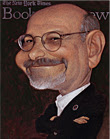About...
Steven Heller
Steven Heller wears many hats (in addition to the the New York Yankees): For 33 years he has been an art director of the New York Times, originally on the OpEd Page and for almost 30 of those years on the New York Times Book Review. Currently he is a senior art director. He also writes book reviews and obituaries for the Times.
He is the founder and co-chair of the MFA Designer as Author program at the School of Visual Arts, New York, where he lectures on the history of graphic design. Prior to this, he lectured for 14 years on the history of illustration in the MFA Illustration as Visual Essay program at the School of Visual arts. He also was director for ten years of SVA’s Modernism & Eclecticism: A History of American Graphic Design symposiums.
With Seymour Chwast he has directed Push Pin Editions, a packager of visual books, and with his wife Louise Fili he has produced over twenty books and design products for Chronicle Books and other publishers.
For over two decades he has been contributing editor to PRINT, EYE, BASELINE, and I.D. magazines, had has contributed hundreds of articles, critical essays, and columns (including his interview column "Dialogue" in PRINT) to a score of other design and culture journals.
As editor of the AIGA JOURNAL OF GRAPHIC DESIGN he published scores of critical and journalistic writers on design, and currently as editor of AIGA VOICE: Online Journal of Design, he continues to help build a critical vocabulary for the field.
The author, co-author, and/or editor of over 100 books on design and popular culture, Heller has worked with a score of publishers, including Chronicle Books, Allworth Press, Harry N. Abrams, Phaidon Press, Taschen Press, Abbeville Press, Thames & Hudson, Rockport, Northlight, and more. He is currently completing "Iron Fists: Branding the Totalitarian State" for Phaidon Press, an anaylsis of how the major dictatorships used graphics to propagate their ideologies.
He has produced or been curator of a number of exhibitions, including "Art Against War," "The Satiric Image: Painters as Cartoonists and Caricaturists," "The Malik Verlag," and "The Art of Simplicissumus: Germany’s Most Influential Satire Magazine," among them. He has organized various conferences, including The School of Visual Arts’ "How We Learn What We Learn," devoted to the future of design education, and the AIGA’s "Looking Closer: Graphic Design History and Criticism."
Heller is also the recipient of the AIGA Medal for Lifetime Achievement in 1999, the Art Directors Club Hall of Fame Special Educators Award in 1996, The Pratt Institute Herschel Levitt Award in 2000, and the Society of Illustrators Richard Gangel Award for Art Direction in 2006.
ประวัติการทำงานของ Steven Heller
เป็นนักวิจารณ์ของบริษัท AIGA ซึ่งเป็นเป็นบริษัท Graphic Design เป็นผู้สร้างบริษัทและเป็นประธานของ MFA Design แผนก Visual Art เป็นบรรณาธิการของหนังสือพิมพ์ 25 ฉบับ ประกอบด้วยPrint, U&LC, Eye Magazine, Graphic Design Issues, Mother Jones ตั้งแต่ปี1986 เขาได้เป็น Art Director Senior และเป็นที่ปรึกษาบรรณาธิการของนิตยสาร New York Time เขียนหนังสือเกี่ยวกับ Graphic Design, Illustrator และการ์ตูนล้อเลียนการเมือง มากกว่า 100 เล่ม เป็นนักเขียนที่ให้ความรู้ที่เกี่ยวกับการออกแบบ Graphic และหนังสืออื่นๆ เช่น หนังสือที่เกี่ยวกับ Typographer- ประวัติศาสตร์ของ Graphic Design- Graphic Design จากสมัย Victorian
ถึงยุค Post modern- Typology จากสมัย Victorian ถึงยุค Post Modern- หนังสือเกี่ยวกับการเป็นนักออกแบบ Graphic Designer
ศิลปะการตกแต่งของอิตาลี่ เป็นการออกแบบในช่วงระหว่างสงคราม
Steven Heller ได้เป็น Art Director ครั้งแรกในปี 1974 ทำงานเกี่ยวกับโฆษณาต่างๆในหนังสือมากมายประกอบด้วยInterview magazine,The New York free Press,Rock Magazine, Screw Magazine, Mobster Time,Evergreen Review And the Irish Arts Center
ได้รับรางวัลเกี่ยวกับการออกแบบใหญ่ๆ 3 รางวัลจากThe National Endowment For the Arts ของ New York Steven
เป็นผู้ดูแลงานนิทรรศการการออกแบบประกอบด้วย “The Art Of Satire” ที่ Pratt Graphic Center และ “Art Against War” ที่ Parson School Of Design ตั้งแต่ปี1986 เขาจะทำงานแนว Modernism & Eclecticismความเป็นมาของการออกแบบ Graphic ของ America
รางวัลที่ได้รับ... ปี 1998 เขาได้รางวัล A Special Educators Award,The Art Diritor’s Club- ปี 1999 ได้รับเหรียญ AIGA เป็นรางวัลผู้ประสบความสำเร็จในชีวิตและในปีเดียวกันได้รางวัลจากสถาบัน Pratt- ปี 2000 ได้รับรางวัล Outstanding Client Award,Graphic Artists Guild





มุมกล้อง ภาพถ่าย 360 องศา
การถ่ายภาพ คือ การบันทึกเหตุการณ์ ณ จุดเวลาใดเวลาหนึ่ง โดยการเก็บสภาพแสง ณ เวลานั้นไว้บนวัตถุไวแสง ผ่านอุปกรณ์รับแสงที่เรียกว่ากล้องถ่ายรูป หลังจากนั้น จะสามารถเปลี่ยนสภาพแสงเหล่านั้นกลับมาเป็นภาพ ได้อีกครั้งหนึ่ง ผ่านกระบวนการล้างภาพ การมองเห็นสิ่งรอบตัว 360 องศา สิ่งที่หมุนรอบตัวที่สามารถมองเห็น ได้โดยรอบ สามารถมองมุมของภาพ ที่เป็นช็อดของภาพแต่ละช็อด จนดูเป็นภาพเคลื่อนไหว และยังสามารถนำมาเป็นมุมมองของการถ่ายรูป และการทดลอง ในการหามุมมอง จากวัตถุ และ คน โดยการศึกษาและทดลองสิ่งที่น่าจะเป็น และได้บทสรุปอะไรบ้างจากการศึกษา การกำหนดมุมกล้องเพื่อการถ่ายภาพเป็นองค์ประกอบหนึ่งที่จะช่วยให้รูปแบบของภาพที่เสนอไปยังผู้ชม ประสบความสำเร็จมากยิ่งขึ้น รูปแบบของการกำหนดมุมกล้องเกี่ยวกับการถ่ายภาพในลักษณะต่างๆ จะมีผลต่ออารมณ์ความรู้สึกของผู้ชม
หมุนรอบวัตถุ




ภาพบุคคล

การมองโดยรอบตัวบุคคล


การถ่ายภาพโดยใช้มุมมอง
การมองเห็นมุมมองที่แตกต่างจากการถ่ายภาพวัตถุ กับ ภาพบุคคล การมองเห็นสิ่งที่แตกต่าง จากองศาของการ
เปลื่ยนมุมในแต่ละมุม การเห็นความเปลื่ยนแปลง สัดส่วนที่แตกต่างจากเดิม
การถ่ายภาพเด็ก
ศึกษาพฤติกรรม การแสดงออก ธรรมชาติในการแสดงออก การมองภาพโดยรวม


การถ่ายภาพบุคคล (Portraits)
การถ่ายภาพบุคคล เป็นการบันทึกโครงสร้างลักษณะ และความนึกคิดของ ผู้ถ่ายภาพ และผู้ถูกถ่ายภาพฉะนั้นภาพถ่ายบุคคลจึงเปรียบเสมือนตัวแทนบุคคลที่ถูกถ่าย และผู้ถูกถ่ายภาพ ฉะนั้น ภาพถ่ายบุคคลจึงเปรียบเสมือนตัวแทนบุคคลที่ถูกถ่าย ทั้งในด้านความนึกคิดและลักษณะท่าทาง
ภาพถ่ายบุคคลที่ดีควรแสดงออกใน 2 ประการ คือ
1. ความนึกและการสร้างสรรค์ของผู้ถ่ายภาพ
2. สามารถแสดงบุคลิกของผู้ถูกถ่ายได้เป็นอย่างดีภาพถ่ายบุคคลที่แสดงออก
ได้ทั้ง 2 ประการดังกล่าวจำเป็นต้องมีความเข้าใจในองค์ประกอบต่าง ๆดังนี้คือ
1. การจัดเสื่อผ้าให้เหมาะสมกับบุคลิกและอาชีพ
2. การจัดฉาก อาจจัดในสตูดิโอ หรือฉากธรรมชาติ
3. การจัดภาพ จัดท่าทาง ของผู้เป็นแบบ
4. การจัดแสง อาจใช้แสงธรรมชาติ หรือแสงไฟประดิษฐ์
4. การจัดแสง อาจใช้แสงธรรมชาติ หรือแสงไฟประดิษฐ์
5. การเลือกใช้กล้อง ฟิล์ม แผ่นกลองแสงและเลนส์ในการถ่ายภาพให้เหมาะสม เลนส์ที่ใช้ในการถ่ายภาพบุคคลควรเป็นเลนส์ถ่ายภาพระยะไกล ความยาวโฟกัสประมาณ 105 มม. หรือ 135 มม.
6. การเลือกมุมกล้องในการถ่ายภาพการศึกษาในการถ่ายภาพ ในระยะแต่ระช่วงของมุมกล้อง
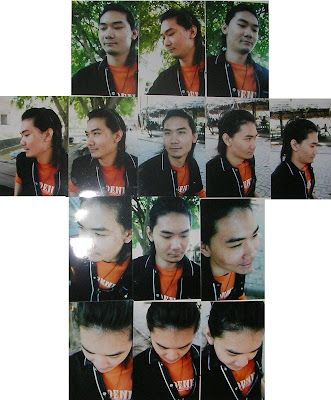
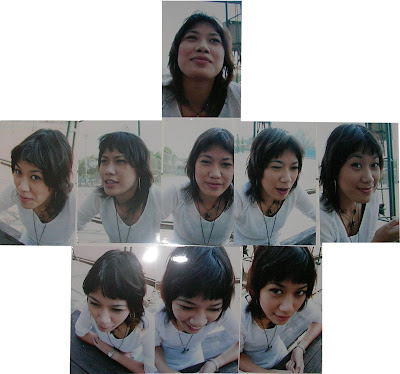



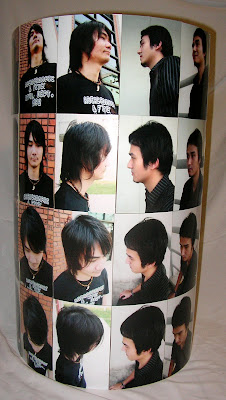


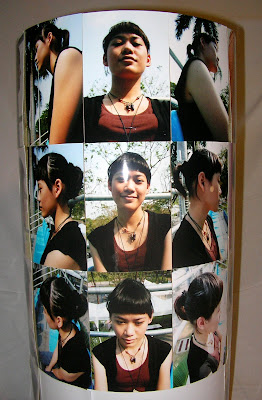

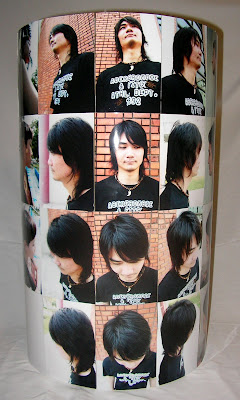
ผลจากการถ่ายภาพ Portrait
มุมกล้องในระดับสายตา
เป็นการตั้งกล้องในระดับเดียวกันกับสายตาของผู้ชม การเสนอมุมแบบนี้ทำให้ผู้ชมรู้สึกเหมือน
อยู่ในเหตุการณ์ต่าง ๆ ด้วยตนเอง
มุมกล้องระดับสูง
เป็นการตั้งกล้องในตำแหน่งเหนือศีรษะโดยตรงของสิ่งที่ถ่าย ภาพที่ถูกบันทึกจะมีมุมมอง
เช่นเดียวกับสายตานกที่มองดิ่งลงมายังพื้นดิน มุมกล้องนี้ให้ความรู้สึกสิ้นหวัง
รวมทั้งตกอยู่ภายใต้อำนาจการควบคุมของผู้ที่อยู่เหนือกว่า อีกทั้งมุมนี้ยังทำให้สิ่งที่ถ่ายมองดูเล็กลง
ทำให้รู้สึกต่ำต้อย
